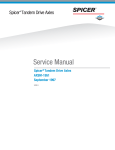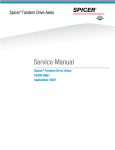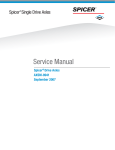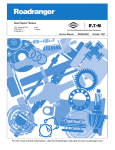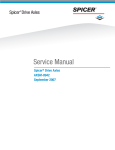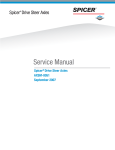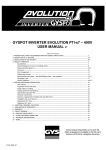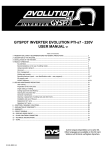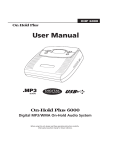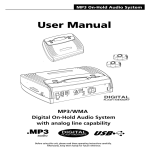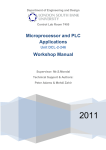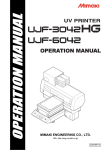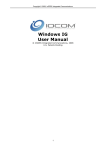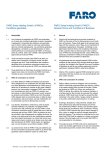Download service manual: g & m models two speed rear
Transcript
Spicer Drive Axles ® Service Manual Spicer® Drive Axles AXSM-8810 January 1998 G155-T, G175-T, M190-T M210-T, M220-T, M230-T Two Speed Axles TABLE OF CONTENTS Axle Identification ................................................................ 1 Model Identification Numbering System ........................ 2 Gear Set Identification ........................................................ 2 Axle Lubricant Recommendations .................................... 3 General Precautions ............................................................. 4 Safety Rebuild Facilities End Yokes and Flanges Cleanliness Features/Power Flow Diagrams .......................................... 5 Axle Components ................................................................. 6 Removal of Differential Carrier from Axle Housing ....... 7 Disassembly Differential Carrier ............................................... 8 Ring Gear and Support Case ............................. 9 Differential ............................................................. 10 Pinion ...................................................................... 11 Cleaning and Inspection ..................................................... 12 Assembly Pinion ...................................................................... 13 Pinion Position ...................................................... 15 Assembly (Continued) Pinion Setting ........................................................ 16 Differential ............................................................. 18 Ring Gear and Support Case ............................. 19 Differential Support Case Installation ............................. 20 Ring Gear and Tooth Contact Pattern ............................. 21 Sun Gear Retainer Installation........................................... 22 Installation of Carrier into Axle Housing ........................ 22 Wheel Bearing Adjustment ................................................ 23 Axle/Torque Specifications ................................................ 24 Two Speed Operating Instructions ................................... 25 Export Improvement for M230-T Model ......................... 26 Recommended Service Tools ............................................. 27 GENUINE SPICER SERVICE PARTS cause premature component failure and may void the warranty. Should an axle assembly require replacement component parts, it is recommended that Spicer Heavy Axle Service Parts be used. Spicer Heavy Axle Service Parts are manufactured under the same rigid specification as are original equipment axle components. This assures the customer who uses genuine Spicer service parts, maximum reliability for a Spicer Heavy Axle assembly. They may be obtained through your vehicle manufacturer. The use of non-original Spicer service parts may The items included in this book are currently being offered as service parts at the time of printing. The part numbers and illustrations are provided specifically for reference purposes only. Therefore, Spicer reserves the right to update this manual without notice or liability. i AXLE IDENTIFICATION JULIAN D ATE CODE DA include customer part number, line set number, and the last six digits of the vehicle serial number. 97 0 70 07 MODEL YEAR The aluminum axle assembly tag contains the following items: serial number, according to the julian date, Dana part number, and the model. The mylar axle assembly tag contains the following items: Dana part number, julian date code, axle model, and ratio. Optional items include customer part number, line set number, and the last six digits of the vehicle serial number. DAY OF YEAR All axle assemblies are identified with two tags. One located on the differential carrier, and the other located on the right hand side of the axle housing. Two types of tags may be found on the axle, an aluminum tag that is riveted on the axle assembly or a coated mylar tag. AR T DANA P PAR ART NUMBER The aluminum differential carrier tag contains the following items: serial number, according to the julian date code, the Dana part number, and ratio. The mylar differential carrier tag contains the following: Dana part number, julian date code, and ratio. Optional items JULIAN D ATE DA CODE JULIAN D ATE DA CODE DANA P AR T PAR ART NUMBER Carrier Tag SN 97070 MJACA000-0X RATIO CUS TOMER CUST PAR T NUMBER ART (OPTIONAL) LAS T SIX DIGITS OF LAST VEHICLE SERIAL NUMBER (OPTIONAL) 0.00 LINE SET NUMBER (OPTIONAL) Carrier Tag DANA P AR T PAR ART NUMBER CUS TOMER CUST T NUMBER ART PAR (OPTIONAL) MODEL JULIAN D ATE DA CODE JULIAN D ATE DA CODE Axle Assembly Tag LAS T SIX DIGITS OF LAST VEHICLE SERIAL NUMBER (OPTIONAL) SN 97070 LINE SET NUMBER (OPTIONAL) MODEL M190-T MJAAB000-0 DANA P AR T PAR ART NUMBER 1 Axle Assembly Tag MODEL IDENTIFICATION NUMBERING SYSTEM M 190 T N Family (G, M) Gearing Type (T = Two Speed) Nominal Load Carrying Capacity (155 = 15,500 Lbs.) (175 = 17,500 Lbs.) (190** = 19,000 Lbs.) (210 = 21,000 Lbs.) (220 = 22,000 Lbs.) (230 = 23,000 Lbs.) Options (N = *No-SPIN® Differential) * No-SPIN® is a registered trademark of Tractech ** Same as 185 = 18,500 Lbs. GEAR SET IDENTIFICATION 260 41-11 MFG. DATE DANA MFG. LOCATION HEAT CODE MATCHED SET NUMBER TOOTH COMBINATION PART NUMBER MFG. DATE TOOTH COMBINATION 260 +15 41-11 HEAT CODE PART NUMBER DANA MFG. LOCATION Manufacturer's Date- Date gear set was made. pinion are marked with a corresponding number (i.e. 260), which identifies them as a matched set. Spicer Trademark- Company logo and location of manufacturing facility. A gear set that does not have the same match set numbers should not be run together. If either ring gear or pinion require replacement, a new matched set must be used. Part number- Ring Gear (GGAGR104 TYPICAL) Tooth Combination(i.e. 41-11)- Indicates the pinion has 11 teeth and the ring gear has 41 teeth which results in a 3:73:1 ratio. Matched Set Number- Spicer ring gears and pinions are manufactured as matched sets. Both ring gear and PINION ETCH Backlash Etch- Indicates backlash setting for assembly. Pinion Etch- Indicator for proper pinion position shim stack up. See Pinion Position Section. 2 AXLE LUBRICANT RECOMMENDATIONS SUBMERSION OR DEEP WATER FORDING In the event the carrier housing should become submerged in water, particularly if over the vent plug, it is recommended that the lubricant be drained and all internal parts be inspected for water damage and/or contamination. Reassemble the carrier to the housing and refill with specified gear lubricant. To ensure proper lubrication and operating temperature, correct lubricants and lubricant levels must be obtained. RECOMMENDED GEAR LUBRICANTS Mineral or Synthetic based hypoid gear lubricants that meet or exceed military specification MIL-L-2105D, and API service classification GL-5, are the minimum requirements for use in Spicer Medium and Heavy Duty Drive Axles. AFTER OVERHAUL OR CHANGE INTERVALS Fill the axle assembly to the bottom of housing fill hole as shown in the illustration below. It is recommended that following an overhaul, each side of the axle be jacked up seperately to approximately six inches and held into position for one minute. This procedure will allow adequate lubricant to flow into the wheel ends and help eliminate the possibility of premature damage to wheel bearings and seals. Lower the vehicle to the floor and allow ten minutes for lube to return to normal level. Check and refill assembly to bottom of fill hole to replace the lubricant that was directed into the wheel ends. The table below indicates which SAE viscosities are recommended for various temperature ranges the vehicle will encounter. AMBIENT AIR TEMPERATURE SERVICE Recommended lubricant change intervals are dependent on the application and operating environment. The following chart should be used to establish proper change intervals. APPLICATION On Highway NOTE: Lubricant close enough to the bottom of the fill hole to be seen or touched is not sufficient. Lubricant must be level with the fill hole. PETROLEUM BASED SYNTHETIC BASED** MILES INTERVAL MILES INTERVAL 100,000 1 Year 250,000 3 Year and 50,000 On-Off Highway 1 Year 100,000 1 Year PATENTED, PRESSURIZED LUBRICATION SYSTEM The lube system for our two-speed axle line is unique in the industry. It's closed and pressurized so that oil constantly flows to critical components. The tapered roller bearings act as a pump which provides pressurized lube through the internal channels in the carrier to the differential bearings, planetary gears, and differential gears. * Severe Service *Severe service includes any applications operating at or near maximum GVW or GCW ratings. This includes normally wet or dusty environment, or consistent high load and low speed applications. **Includes Semi-Synthetic blends that meet MIL-L-2105D specifications. 3 GENERAL PRECAUTIONS IMPORTANT READ THIS SECTION BEFORE STARTING ANY SERVICE PROCEDURES REBUILD FACILITIES A suitable holding fixture or carrier overhaul stand is desireable, but not necessary to rebuild these units. Alternatley, a sturdy shop table of approximately 30 inches in height can be used with suitable means to hold the carrier securely for rebuild operations. A light chain hoist should be used to relocate the carrier housing and to install or remove the ring gear and support case assembly. Safety glasses should be worn at all times when assembling or disassembling axles. SAFETY PRECAUTIONS Proper service and repair of vehicle components is important to the safe and reliable operation of all motor vehicles. This applies particularly to driving axles such as the ones described in this manual. The procedures recommended and described in this manual are tested, effective methods for performing service operations. Follow each procedure closely, making use of both the text and illustrations. Some of these service procedures show the use of certain tools designed specifically for the operation being performed. They are shown as a preferred means of performing the operation. It is not practical to anticipate and advise the service trade of all possible alternative methods, and of all possible hazardous consequences that could occur. END YOKES AND FLANGES CAUTION: Hammering on end yokes can close in the bearing bores or misalign yoke lugs and result in early failures of journal needle bearings or other driveline components. Serious damage can also be done internally to the ring and pinion set or pinion bearings by hammering on external parts. End yokes or companion flanges should be removed or installed using the recommended methods outlined in this manual. CLEANLINESS Axle components should be steam cleaned prior to removal from the vehicle. Dirt is abrasive and will cause premature wear of otherwise serviceable parts. Service personnel should use a wash tank for thorough cleaning of parts just prior to reassembly. Accordingly, anyone who uses a service procedure or tool different than shown must insure that their safety, and the vehicle's safety, will not be jeopardized by the service method selected. CAUTION BRAKE LININGS CONTAIN NON-ASBESTOS FIBERS BREATHING BRAKE DUST MAY BE HAZARDOUS TO YOUR HEALTH AND MAY CAUSE SERIOUS RESPIRATORY OR OTHER BODILY HARM. AVOID CREATING DUST DO NOT REMOVE BRAKE DRUM WITHOUT PROPER PROTECTIVE EQUIPMENT. DO NOT WORK ON LININGS WITHOUT PROPER PROTECTIVE EQUIPMENT. DO NOT REPLACE LININGS WITHOUT PROPER PROTECTIVE EQUIPMENT. DO NOT ATTEMPT TO SAND, GRIND, CHISEL, FILE, HAMMER OR ALTER BRAKE LININGS IN ANY MANNER WITHOUT PROPER PROTECTIVE EQUIPMENT. FOLLOW 0.S.H.A. STANDARDS FOR PROPER PROTECTIVE DEVICES TO BE USED WHEN WORKING WITH BRAKE MATERIALS. 4 TWO SPEED AXLE FEATURES This Spicer axle assembly consist of a full float, cold formed and welded, banjo-type housing member to which the differential carrier assembly is bolted. The banjo housing is the vehicle load carrying member, and the differential carrier assembly is the torque transmitting portion of the axle. It consist of a primary hypoid gear set for high range operation, and a secondary planetary type spur gear set, which is combined with the primary gear set, for low range operation. Range changes are easily made by means of a hand control button mounted on the gear shift lever (See Two-Speed Operating Instructions, Pg. 25) The control button causes the planetary sun gear to act as a sliding clutch member, and moves it in and out of engagement with two clutching plates to complete range changes. POWER FLOW DIAGRAMS HIGH RANGE In high range, the sun gear locks the planet gears with the planet plate and the ring gear. The unit then functions as a single reduction axle. Power flows in the pinion to the ring gear through the differential case to the differential cross shaft. The cross shaft transfers it through the differential pinion mates to the left and right differential side gears, and finally to the axle shafts. LOW RANGE In low range, engine power is transmitted to the hypoid ring gear as before. It then flows to the ring gear internal spur teeth, which transfers it to the planet gears that are attached to the differential case. Because the sun gear is clutched to a stationary retainer plate, it cannot rotate and acts as a reaction member for the planet gears. This causes the planet gears to rotate around the sun gear, driving the differential case at a speed slower that the ring gear, creating the additional low range reduction ratio and further multiplying engine torque. From this point, power flows in the same sequence as when the axle is in high range. 5 AXLE COMPONENTS Axle Shaft Sun Gear Hex Bolt (255-275 Lb-Ft) (298-339 N-m) Vent Plug Fill Plug (35-45 Lb-Ft) (47-61 N-m) Temperature Sensor Plug (35-45 Lb-Ft) (47-61 N-m) Differential Bearing Cap Sun Gear Retainer Plate Adjusting Ring Differential Bearing Cup Differential Bearing Cone Differential Thrust Plate Ring Gear Ring Gear Bolt (See Torque Specifications) Magnetic Drain Plug (35-45 Lb-Ft) (47-61 N-m) Differential Support Case Planet Gear Shaft Differential Case (Planetary) Half Planet Gear Mounting Plate Planet Gear Differential Bearing Cap Bolt (See Torque Specifications) Hex Bolt (30-40 Lb-Ft) (41-54 N-m) Differential Cross Shaft Differential Bearing Cap Washer Differential Case Cap Half Differential Case Bolt (See Torque Specifications) Differential Gear Thrust Washer Differential Pinion Mate Washer Adjusting Ring Retainer Differential Pinion Mate Thrust Washer Shift Fork Assembly Differential Support Case Pinion Shift Fork Shaft Set Screw Pinion Pilot Bearing Cap Bolt (See Torque Specifications) Shift Housing Seal Pinion Pilot Bearing Cap ® Optional No-SPIN Pinion Oil Slinger Pinion Pilot Bearing Oil Slinger Seal Inner Pinion Bearing Cone Inner Pinion Bearing Cup Pinion Bearing Spacer (Selective) Stud Washer Nut Carrier Housing Carrier Mounting Bolt (See Torque Specifications) Outer Pinion Bearing Cup Outer Pinion Bearing Cone Pinion Oil Seal End Yoke Assembly 6 Flanged Hex Nut (700-900 Lb-Ft) (949-1,220 N-m) REMOVAL OF DIFFERENTIAL CARRIER FROM AXLE HOUSING 1. Shift the axle into low range. (See Two Speed Operating Instructions, Pg. 25) 2. Remove the drain plug and drain lubricant. 3. Remove the shift unit from carrier assembly. NOTE: Shift unit contains lube. Provide container to catch lubricant. NOTE: For servicing the shift unit, refer to Vehicle Service Manual. 4. Disconnect drive shaft at rear u-joint. Figur iguree 1 NOTE: If ring or pinion bearings are to be removed, break loose pinion nut at this time. 6. Support the carrier on a roller jack. 7. 5. Remove axle shaft cap screws and lock washers, or stud nuts and cone locks. Remove axle shafts. If gasket is assembled between the hub and shaft, discard the old gasket and replace with a new one at time of reassembly. Remove the carrier-to-housing bolts. 8. Break carrier loose from housing with use of pry bars behind carrier flange mounting face. See Figure 1. Removal of Carrier from Axle Housing Complete 7 DISASSEMBLY OF DIFFERENTIAL CARRIERS Carrier Housing Differential Bearing Cup Differential Bearing Cap Sun Gear Retainer Plate Support Case and Differential Assembly Sun Gear Adjusting Ring Differential Bearing Cap Bolt (See Torque Specifications) Adjusting Ring Retainer Retainer Plate Bolt (See Torque Specifications) 1. Place the carrier in a suitable holding fixture such as a carrier repair stand. If ring gear and pinion are to be reused, measure gear backlash prior to disassembly. Hex Bolt (30-40 Lb-Ft) (41-54 N-m) NOTE: Shaft will only drive out in one direction. 7. Remove sun gear. 8. Remove four sun gear retainer bolts and sun gear retainer plate. 2. For double reduction models, remove the two bolts and the double reduction plate. (Proceed to step 7) NOTE: For ease of disassembly, the ring gear bolts can be loosened at this time. 3. For two speed models, remove the shift fork spring and seal from the carrier housing. 9. Remove adjusting ring retainers. 10. Remove four differential bearing cap bolts. 4A. New Style: 11. Back out either adjusting ring to relieve preload. Remove set screw and shift fork shaft. Remove shift fork. (Proceed to step 7) 12. Remove bearing caps. 4B. Old Style: 13. Remove adjusting rings. 14. Lift the ring gear and differential sub-assembly out of carrier. The ring gear side of the subassembly must be tipped up for the ring gear to clear the pinion roller bearing retainer. Remove the shift fork shaft snap ring, using suitable snap ring pliers. Be sure to retrieve the retaining ring so that it will not be lost in the differential carrier. 5. Remove sealer from shift fork shaft holes. NOTE: Use care to avoid damage to the ring gear and pinion. 6. Remove shift fork shaft by using a drift and hammer. Differential Disassembly Complete 8 RING GEAR AND SUPPORT CASE DISASSEMBLY Ring Gear Ring Gear Bolt (See Torque Specifications) Planetary Gears Differential Support Case Differential Subassembly Differential Thrust Plate Differential Support Case Planetary Gear Shafts Planetary Gear Mounting Plate Differential Bearing Cone Differential Gear Thrust Washer 5. Remove planetary gears and planetary gear shafts. 1. Prior to disassembly, match mark support case halves for reassembly in the same position. See Figure 2. 6. Turn assembly over and support on differential subassmbly dowel pins. CAUTION: Care must be taken to keep differential subassembly properly positioned in support case to prevent damage when removing ring gear. 7. 8. Lift support case form differential subassembly. Remove thrust washer from differential subassembly. Figur iguree 2 2. Remove ring gear bolts. Remove differential support case from ring gear using pry bars. 9. If either the left or right differential support case bearings are to be replaced, remove them using a suitable puller. See Figure 3. NOTE: It is recommended that whenever the ring gear bolts are removed, they be replaced with a new set. 3. Remove aluminum differential thrust plate. NOTE: Thrust plate may be retained in support case, due to oil rentention. It should be removed and cleaned before reassembly. 4. Remove planetary gear mounting plate. Use care to avoid damage to surfaces of plate and planetary gear shafts. Rotate ring gear to make sure support case is seated squarely on differential subassembly. Using a soft hammer, tap each side of ring gear alternatley to remove from support case half. Figur iguree 3 9 Ring Gear and Support Case Disassembly Complete DIFFERENTIAL DISASSEMBLY Differential Case Cap Half Differential Pinion Mate Differential Pinion Mate Thrust Washer Differential Case Flange Half Differential Gear Thrust Washer Differential Cross Shaft Differential Side Gear Differential Case Bolt (See Torque Specifications) NOTE: Differential case halves are matched and marked during the manufacturing process. No further marking necessary. See Figure 4. 1. Remove differential case bolts and lift off right hand case half. 2. Remove thrust washer and differential side gear. 3. Lift out cross shaft, differential pinions, and thrust washers. NOTE: Inspect all parts, inlcuding the matched surfaces of the case itself. Where necessary, replace all worn parts. If excessive wear is noticed on all parts, it is suggested that the complete differential assembly be replaced. Figur iguree 4 If any gears are to be replaced, they must be replaced in sets. Inspect thrust washers for scoring and excessive wear; replace if necessary. 4. Lift out differential side gear and thrust washer. Differential Disassembly Complete 10 PINION DISASSEMBLY Pinion Pilot Bearing Cap Pinion Pilot Bearing Pinion Pinion Position Spacer (Selective) Oil Slinger Seal Carrier Housing Retainer Plate Bolt (See Torque Specifications) Outer Pinion Bearing Cup Inner Pinion Bearing Cone Inner Pinion Bearing Cup Flanged Hex Nut (700-900 Lb-Ft) (949-1,220 N-m) Pinion Bearing Spacer (Selective) Washer Carrier Mounting Bolt (See Torque Specifications) Outer Pinion Bearing Cone Pinion Oil Seal End Yoke Assembly 1. Turn the carrier to a vertical position and remove the four pilot bearing cap bolts. Lift the pilot bearing cap from the roller bearing and carrier housing, tapping with soft hammer from underneath side if necessary. 6. Remove pinion. 7. 2. Turn the nose of the carrier to a horizontal position to remove the flanged hex nut. Hold the end yoke stationary, and remove the flanged hex nut and washer. Near the spline end of the pinion and between the pinion bearings is a (selective) pinion bearing spacer used for pinion bearing preload. Retain this spacer for possible use in reassembly. 8. Remove pinion pilot bearing from end of pinion. 9. Remove inner bearing cone from pinion. 10. Remove the pinion oil seal. Discard the seal and replace it with a new one at time reassembly. Remove the outer pinion bearing cone. 11. Rotate carrier to pinion nose down position. Remove the pinion oil slinger seal from the carrier and discard. Install a new seal at the time of reassembly. 12. With nose of the carrier down, remove the outer pinion bearing cup. Figur iguree 5 3. Remove the end yoke using a suitable puller. See Figure 5. 13. Turn the carrier over and remove the inner bearing cup. 4. Replace flanged hex nut (finger tight). Tap pinion free of bearing with soft hammer. CAUTION: Do not nick the carrier bearing bore. 5. Supporting pinion from inside carrier, remove flanged hex nut. Pinion Disassembly Complete 11 CLEANING AND INSPECTION CLEANING GEARS 1 . Parts should be cleaned with emulsion cleaners or petroleum base cleaning solvent. NOTE: Alkaline type solutions may cause damage to machined surfaces and should be avoided. 2 . Make sure interior of axle housing is clean prior to reassembly. 3 . Clean all gasket surfaces of old material. Inspect gears for excessive wear or damage. Replace gears that are pitted, scored, broken, or worn. DRYING Use soft, clean, lintless towels or rags to dry components after cleaning. Bearings should not be dried by spinning with compressed air. This can damage mating surfaces due to the lack of lubrication. SHAFTS After drying, parts should be coated with a light coat of lubricant or rust inhibitor to prevent damage from corrosion. If parts are to be stored for a prolonged period, they should be wrapped in wax paper. Inspect shafts for nicks or scoring. INSPECTION Prior to reassembly, inspect parts for signs of excessive wear or damage. Replacement of these parts can prevent premature failure and costly downtime. SPLINES Inspect all splines for excessive wear, distortion from twisting, and cracking. BEARINGS Bearing surfaces should be inspected for pitting, excessive wear, or overheating. HOUSINGS THRUST WASHERS Inspect thrust washers for scoring and cracking. Inspect housing for stripped threads and bending fatigue. 12 PINION ASSEMBLY Pinion Pilot Bearing Cap Pinion Pilot Bearing Pinion Pinion Oil Slinger (Selective) Oil Slinger Seal Carrier Housing Retainer Plate Bolt (See Torque Specifications) Inner Pinion Bearing Cone Inner Pinion Bearing Cup Outer Pinion Bearing Cup Flanged Hex Nut (700-900 Lb-Ft) (949-1,220 N-m) Pinion Bearing Spacer (Selective) Washer Carrier Mounting Bolt (See Torque Specifications) Outer Pinion Bearing Cone Pinion Oil Seal End Yoke Assembly 5. Use a feeler gauge or shim stock to ensure bearing cups are completly seated in bearing bores (.0015" approx.). This is necessary for proper pinion position. See Figure 8. 1. Assemble the proper pinion position spacer, oil slinger seal and inner bearing cone onto the pinion. 2. Press pinion pilot bearing on the pinion. 6. Install inner pinion oil slinger seal into the carrier with the tabs locking into the oil channel. Make sure the flat side of the seal is seated against the bottom of the bearing cup bore so that the lip side will be against the pinion oil slinger. 3. Stake pinion pilot bearing onto pinion in six places, using a center punch or equivalent tool. See illustration on right. 7. NOTE: Make sure all carrier bores are free from all nicks, dirt, or any other contamination. 4. Install the inner and outer bearing cups into the carrier. Install pinion into carrier using slow steady movement when sliding through inner bearing cup and seal. The pinion should be restrained from end movement by using a retaining strap. See Figure 9. Figur iguree 9 Figur iguree 8 13 PINION ASSEMBLY 8. Rotate carrier to a vertical position. Place pinion bearing spacer (selective) on pinion. Install outer bearing cone onto pinion. Pinion bearing spacers (selective) are available in the following thicknesses. Inches .700 MM 17.780 Inches .714 MM 18.136 .701 17.805 .715 18.161 .702 17.831 .716 18.186 .703 17.856 .717 18.212 .704 17.882 .718 18.237 .705 18.907 .719 18.263 9. Inspect end yoke seal surface for grooves caused by seal lip. If grooves can be detected with a fingernail, yoke should be replaced or have repair sleeve installed. .706 18.932 .720 18.288 .707 18.958 .721 18.313 .708 18.983 .722 18.339 .709 18.009 .723 18.364 10. Assemble end yoke, washer and old flanged hex nut onto pinion. Torque nut to 700-900 Lb-Ft (9491,220 N-m). The old nut can be used during this adjustment phase of the assembly, saving the new one for final assembly. .710 18.034 .724 18.390 .711 18.059 .725 18.415 .712 18.085 .726 18.440 .713 18.110 .727 18.466 NOTE: The reason for not assembling a new pinion oil seal at this time is due to the possibility of having to adjust pinion preload or pinion position. It would be necessary to again remove the seal and, as mentioned, whenever seals are removed, they are to be discarded because of possible damage. NOTE: Inspect pinion pilot bearing cap for proper spotface and chamfer at the four bolt holes as shown in Figure 10. If spotface and chamfer are not present, machine as required .030 chamfer X 45º for holes and 1.25" spotface X .030 deep at four places. 11. Remove pinion retainer strap. Using an in-lb torque wrench rotate pinion noting rolling torque. Rolling torque of pinion should read between 20-50 in-lb (2.3-5.7 N-m). To increase preload, decrease thickness of preload spacer: to decrease preload, increase thickness of preload spacer. Every .001" (.025 mm) change in thickness of preload spacer changes torque to rotate by approximately 30 in-lb. 14. Rotate carrier to vertical position with yoke down. Install pinion pilot bearing cap using soft hammer if necessary. NOTE: A pinion bearing spacer (selective) is used to develop pinion bearing preload. See list in next column for available thicknesses. Measure the spacer with a micrometer before assembly to insure correct thickness. Chamfer .030 x 45º 15. Install four retainer bolts. Torque to: 12. Remove flanged hex nut, washer and end yoke. Apply a light coat of lubricant to the lip of the seal and assemble into housing. G Model 70-80 LbFt (95-108 N-m) M Model 110-125 Lb-Ft (149-169 N-m) 13. Assemble end yoke, washer, and new flanged hex nut. Torque to 700-900 Lb-Ft (949-1,220 N-m). Recheck torque to rotate. .030 Deep x 1.25 Spotface Figur 0 iguree 1 10 Pinion Assembly Complete 14 PINION POSITION Ring gears and pinions are supplied in matched sets only. Matching numbers on both the pinion and ring gear are etched for verification. If a new gear set is being used, verify the number of each pinion and ring gear before proceeding with assembly. See Gear Set Identification, Pg. 2. Pinion Oil Slinger Beginning with carriers GGA-1007032 and MJA-1007160, a new method of setting pinion position has been adopted. A number is etched on the machined surface under the roller bearing retainer plate on each carrier. This number is used in conjunction with the number etched on each pinion to determine the proper pinion bearing spacer (selective) for proper assembly. It eliminates the need for measuring with special gauge tools. See Figure 7. Nominal Mounting Distance Centerline of Ring Gear A plus (+) number etched on the pinion would mean that number must be added to the nominal mounting distance to get the required mounting distance. EXAMPLE: If pinion is etched +3, the required mounting distance is more than nominal by .003 in. (.076 mm). This means the pinion would require .003 in. (.076 mm) thinner shim between pinion and oil slinger seal than a pinion etched with "0" to allow for this difference. To achieve proper pinion position, decrease the pinion position spacer thickness by .003 in. (.076 mm). Figur iguree 7 Pinion position is based on the mounting distance measured from the centerline of the ring gear to the back of the pinion head (See Illustration, top of next column). This dimension is controlled by shimming between the oil slinger seal and pinion head with a pinion position spacer (selective). Similarily, if the pinion is marked -3, the shim required between pinion and oil slinger seal would be .003 in (.076 mm) thicker than if pinion was etched "0" to allow for this distance. To acheive proper pinion position, increase the pinion position spacer thickness by .003 in. (.076 mm). On the nose of each pinion either a plus (+), minus (-), or a zero (0) will be etched. See Gear Set Identification, Pg. 2. This number represents the amount in thousandths of an inch (.001) to be added or subtracted from the nominal mounting dimension for the best running position for that particular gear set. The number etched on the carrier also refers to the mounting distance, based on a "0" etched pinion. This number represents thicness in thousandths of the pinion position spacer (selective) required for a "0" etched pinion. 15 PINION POSITION The following examples illustrate how the carrier etch and the pinion etch interact: EXAMPLE "A" EXAMPLE "B" Number etched on nose of pinion +3 -2 Number etched on carrier 63 61 Add or subtract pinion etch from carrier etch to get correct pinon postion spacer. Pinion position spacers (selective) are available in the following thicknesses. Inches MM .052 1.321 .055 1.397 .058 1.473 .061 1.549 .064 1.626 .063 -.003 .061 +.002 .067 1.702 .070 1.778 .060 .063 .073 1.854 .076 1.930 .079 2.007 .082 2.083 Select a pinion postion spacer that is closest to the calculated value from table. NOTE: The pinion position spacer functions as a selective shim to determine the position of the pinion mounting distance. NOTE: Measure the new pinion position spacer with a micrometer before assembly to insure correct thickness. Be sure mounting surfaces and shims are free of dirt and nicks prior to assembly or leaks will occur and pinion position can be affected. PINION SETTING When a new gear set is being installed, use a micrometer to measure the thickness of the old pinion position shims. Measure each shim separately and add together to get the total thickness of the original build-up. If either or both the pinions are etched beyond the values on this chart, follow the same procedure to establish correct pinion position. For example if the old pinion is etched –12 and the new pinion is etched +9, add .021 inch to the thickness of the original shims. NOTE: If old shims are bent or mutilated they should be replaced. If a new gear set is being used, notice the (+), (–) or "0" etching on both the old and the new pinions, and adjust the thickness of the shims to compensate for the difference of these two figures (as shown in table on next page). After determining the new total build up of pinion position shims, round the figure off to the nearest multiple of .005 inch. Use the Pinion Setting Chart on the next page as a guideline to set the pinion. For example, if the old pinion is etched +2, and the new pinion is –2, subtract .004 in. from the thickness of the original shims used to position the pinion. 16 PINION SETTING 17 DIFFERENTIAL ASSEMBLY Differential Case (Planetary) Half Differential Pinion Mate Differential Pinion Mate Thrust Washer Differential Case Cap Half Differential Gear Thrust Washer Differential Cross Shaft Differential Side Gear Differential Case Bolt (See Torque Specifications) 1. Apply a small amount of lubricant to all mating surfaces. This will keep the thrust washers in place during assembly, and provide for initial lubrication. 2. Place thrust washer and differential side gear in differential case (planetary) half. 3. Assemble differential components and place into differential case (planetary) half. 4. Place side gear and thrust washer in position on differential pinion mates. 5. Position differential case cap half onto above assembly, making sure match marks line up. See Figure 6. Figur iguree 6 4. Install differential case bolts (M230-T export model has 12 bolts). Tighten alternately and evenly. Torque bolts to: G Model: 70-80 Lb-Ft (95-108 N-m) M Model: 110-125 Lb-Ft (149-169 N-m) Differential Assembly Complete 18 RING GEAR AND SUPPORT CASE ASSEMBLY Ring Gear Ring Gear Bolt (See Torque Specifications) Planetary Gears Differential Support Case Differential Subassembly Differential Thrust Plate Differential Support Case Planetary Gear Shafts Planetary Gear Mounting Plate Differential Bearing Cone Differential Gear Thrust Washer 1. Install differential bearing cones onto hub of support cases. fered teeth facing the planet gears. Tap the plate with a soft hammer, if necessary, to seat the plate against the differential subassembly. NOTE: To protect bearings during the following steps. install bearing cups on bearing cones. NOTE: Be sure that the planetary gear shafts and dowel pins are flush to below flush prior to installing thrust plate. 2. Apply lubricant to thrust washer surface and install in differential support case. 7. 3. Install differential assembly into differential support case. Rotate differential assembly to assure proper installation. Apply lubricant to each side of the differential thrust plate and position the thrust plate on the planetary gear mounting plate. 8. Place the support case on the ring gear and line up the bolt holes. If old ring gear is used make sure match marks are aligned. 4. Install ring gear on differential support case, aligning bolt holes. Make sure ring gear is seated. NOTE: If old ring gear is used, make sure match marks are aligned. NOTE: See Pg. 26 for M230-T export model assembly instructions of ring gear bolts and retainers. 5. Lubricate and install the four planetary gear shafts in the holes of the differential subassembly. Place the planetary gears in position on the planetary gear shafts. 9. Install and tighten the ring gear bolts alternately and evenly. Torque bolts to: G Model 110-125 Lb-Ft (149-169 N-m) NOTE: Remove any burrs from planet gear mounting plate. M Model 160-180 Lb-Ft (217-244 N-m) Ring Gear and Support Case Assembly Complete 6. Position the planetary gear mounting plate on the planetary gear shafts and dowels, with the cham19 DIFFERENTIAL SUPPORT CASE INSTALLATION Carrier Housing Differential Bearing Cup Differential Bearing Cap Sun Gear Retainer Plate Support Case and Differential Assembly Sun Gear Adjusting Ring Differential Bearing Cap Bolt (See Torque Specifications) Adjusting Ring Retainer Retainer Plate Bolt (See Torque Specifications) 1. Install ring gear support case assembly into carrier housing. The ring gear side of the support case must be tipped to clear the pinion roller bearing retainer plate. Care should be taken to avoid damage of ring and pinion gear teeth and bearings. Place bearing cups into position Hex Bolt (30-40 Lb-Ft) (41-54 N-m) 6. Once proper backlash is established, torque bearing cap bolts to: G Model 220-250 Lb-Ft (298-339 N-m) M Model 290-350 Lb-Ft (393-475 N-m) 7. 2. Assemble differential bearing caps. Install bearing cap bolts (finger tight only). Install adjusting rings. Install adjusting ring retainers, washers, and bolts. Torque retainer bolts to 30-40 Lb-Ft (41-54 N-m). NOTE: Assemble adjusting rings so that the side with two shoulders is facing out to ensure clearance for the bearing (Inside face has only one shoulder). See Figure 11. 3. Tighten adjusting ring on back side of ring gear until there is zero (0) backlash between the ring gear and pinion. Proper Adjusting Ring Installation 4. Next, tighten adjusting ring (on the tooth side of ring gear) until cup is seated. Continue to tighten adjusting ring until backlash has returned to measurement taken prior to disassembly. Out side FFace ace Outside Adjusting Ring 5. Check ring gear and pinion backlash in four equally spaced positions around the ring gear with a dial indicator. Relief for Clear ance Clearance Inside FFace ace NOTE: If backlash does not vary more than .003 in. and the average backlash is between .008-.016 in. or (.20.40 mm) the setting is acceptable. Figur 1 iguree 1 11 Ring Gear and Support Case Assembly Complete 20 RING GEAR AND PINION TOOTH CONTACT PATTERN The procedures to the right are to be used to establish proper gear tooth pattern after assembly of the carrier is complete. NOTE: If matched sets are being reused, measure and record backlash before disassembly, and reassemble to the same backlash. This will match ring and pinion gears to the established wear patterns. Hand rolled patterns will cover less area than the gear pattern established by previous service. STEP 1. Paint 1/4 ring gear with marking compound on both the drive and coast side. STEP 2. Rotate ring gear at least one complete revolution in both directions while load is being applied. CORRECT GEAR PATTERNS FOR GLEASON CUT GEARS L I G H T LY L OA D E D H E A V I LY L OA D E D NOTE: Tooth contact pattern, on this axle model, can be moved only by adjusting backlash. The contact pattern can be moved in the direction of heel-to-toe, and toe-to-heel; Depth of the pattern cannot be adjusted. If an acceptable tooth contact pattern cannot be established within limits of backlash, contact Spicer Service at 1-800-666-8688. 21 SUN GEAR RETAINER INSTALLATION NOTE: See M230-T export model assembly instructions of Sun Gear Retainer, Pg. 27. Seal .1 25" .12 8 mm) (3.18 (3.1 1. Install sun gear retainer plate with chamfered teeth facing out and four bolts. For double reduction models: Install the two bottom bolts only. Torque bolts to 220-250 Lb-Ft (298-339 N-m). NOTE: If lock plates will not fit correctly over bolts and retainer plate, tighten the bolt until lock plate can be installed. Spring 2. Install sun gear. For double reduction models: Install the double reduction plate, install two bolts and torque to 220-250 Lb-Ft (298-339 N-m). Figur 2 iguree 1 12 4. Insert and tighten set screw 30-40 Lb-Ft (41-54 N-m). 3. For two speed models, slide shift fork into carrier housing and position on sun gear. Install shift fork shaft through hole in carrier housing and shift fork. 5. Install shift fork seal and spring. See Figure 12. Sun Gear Retainer Installation Complete INSTALLATION OF CARRIER INTO AXLE HOUSING 1. Thoroughly clean the inside of the carrier housing and inspect the housing mounting surface for nicks and general cleanliness. Stone the surface if necessary to remove burrs or nicks. 4. Install the carrier assembly into the axle housing. Clean the mounting bolts, and coat with Loctite #277 (red), or its equivalent, and install. Tighten bolts evenly in cross pattern. See torque specifications for carrier mounting bolts. 2. Apply an 1/8" bead of Loctite #518 gasket eliminator onto the axle housing mounting flange and around each bolt hole. See Figure 13. 5. Allow one hour cure time for gasket material before adding hypoid gear lubricant. 6. Remove the old axle flange gasket and clean mating surfaces of the hub and axle flange. 7. Install the new axle flange gasket. 8. Install the axle shafts to proper location. Torque the axle flange nuts to vehicle manufacturers specifications. 9. Clean drain plug and install. Fill unit to proper level with hypoid gear lubricant. Loc tit 18 Loctit titee #5 #51 sk Gask skeet Elimina Eliminattor Ga Figur 3 iguree 1 13 3. Thread 2 studs into the axle housing 1800 apart. This will eliminate rotation of the carrier assembly after it makes contact with the gasket material. NOTE : Lubricant close enough to bottom of fill hole to be seen or touched is not sufficient. Lubricant must be level with the fill hole. Installation of Carrier Complete 22 , , ,, ,,, ,, , , WHEEL BEARING ADJUSTMENT NOTE: Wheel bearings should be adjusted following vehicle manufacturers recommended maintenance schedule. 1. Block wheels not being adjusted to insure that vehicle will not roll. Release emergency brake. 2. Raise wheel to be adjusted off of the ground. Make certain wheel rotates freely. 3. Remove axle shaft. 4. Remove outer adjusting nut and lock if tabs are broken. 5. Torque inner wheel nut to 50 Lb-Ft (68 N-m) while rotating wheel one direction, then the other direction. Back off inner nut 1/4 turn. NOTE: When replacing wheel bearings, new bearings must be re-seated to insure maximum service reliability. After the hub and bearings are assembled in place on the spindile, install the inner adjusting nut. Tighten the inner adjusting nut to 120 - 140 Lb-Ft (163-190 N-m), while rotating the hub to seat the bearings. Back off the adjusting nut 1/2 turn and follow the proedure outlined in step #5. LUBRICANT LEVEL 6. Install lock against inner wheel nut, with locking portion positioned on either the flat side of inner nut or peak of inner nut, as shown. 7. Install outer wheel nut and torque to 250-275 Lb-Ft (340-373 N-m). Rotate wheel in both directions. Wheel must rotate freely, with out binding. 8. Bend one tang of lock over flat portion of outer wheel to secure. 9. Remove old axle flange gasket and clean mating surfaces of hub and axle flange. 10. Install new axle flange gasket. 11. Install axle shaft. Torque axle nuts to vehicle manufacturers specifications. Wheel Bearing Adjustment Complete 23 AXLE/TORQUE SPECIFICATIONS Axle Specifications It em Item Pinion Bearing Preload* Torque Wrench Differential Ring Gear to Pinion Backlash Lubrication Lube Capacity (Approx.**) Lube Capacity (Approx.**) Model U.S. Me tric Metric G, M 20 - 50 Lb-in 2.3 - 5.7 N-m G, M .008" - .016" .20 - .41 mm G M 25.0 pints 35.0 pints 11.8 liters 16.6 liters * Pinion bearing preload is established prior to installation of pinion seal. ** Capacity will vary depending on the housing angle in each vehicle. Fill to lower edge of fill hole in rear of axle housing as shown on Page 22. Fasteners Position Model Thr ead Thread Flanged Hex Nut Fill & Magnetic Drain Plugs Adjusting Ring Retainer Bolts Differential Case Bolts Gr ade Grade Lb-Ft G, M 1-1/4" - 12 700 - 900 G, M 3/4" - 14 8 35 - 45 G, M 3/8" - 16 8 30 - 40 G 7/16" - 14 8 115 - 135 M 1/2" - 13 8 70 - 80 Carrier Mounting Bolts G 1/2" - 13 8 100 - 120 M 5/8" - 11 8 240 - 260 Ring Gear Bolts G 1/2" - 13 8 110 - 125 M 9/16" - 12 8 160 - 180 Differential Bearing Cap Bolts G 5/8" - 18 8 220 - 250 M 3/4" - 16 8 290 - 350 Pinion Pilot Bearing Retainer Bolt G 7/16" - 14 8 70 - 80 M 1/2" - 13 8 110 - 125 Sun Gear Retainer Bolt@ G, M 5/8" - 18 8 255 - 275 @ On models equipped with Sun Gear Lock Plate (See Page 27), Retainer Bolt Torque is 220 - 250 Lb-Ft (298 - 339 N-m). 24 N-m 949 - 1,220 47 - 61 41 - 54 156 - 183 95 - 108 136 - 163 325 - 352 149 - 169 217 - 244 298 - 339 393 - 475 95 - 108 149 - 169 345 - 373 TWO SPEED OPERATING INSTRUCTIONS The Spicer two-speed rear axle may be specified in combination with four and five speed manual transmissions. There are 8-10 possible gear selections. The axle can be spit shifted or shifted to high when road speed is achieved. By studying Figure 14 and using the following shift sequences, you can refine and make using the Spicer two-speed axle an automatic occurance. LOW TO HIGH SHIFTING With accelerator down, move the axle selector switch to HI. "HI" R ANGE RANGE Release accelerator. When shift is complete, depress accelerator. HIGH TO LOW SHIFTING With accelerator down, move the axle selector switch to LO. "L O" R ANGE "LO" RANGE Rapidly release and depress accelerator. When shift is complete, depress accelerator. SPLIT SHIFTING THE TRANSMISSION AND AXLE Upshifting While shifting transmission up to the next higher gear, Figur 4 iguree 1 14 Move axle selector switch to LO before engaging clutch. Downshifting With the accelerator down, move the axle selector switch to HI (pre-select). Shift transmission down to the next lower gear. 25 EXPORT IMPROVEMENT FOR M230-T MODEL 4. Torque the ring gear bolts to 160-180 Lb-Ft (217244 N-m). RING GEAR BOLT RETAINER INSTALLATION 1. Follow Ring Gear and Support Case Assembly procedures 1 thru 8. 5. Bend tabs on retainers over flats of bolts. See Figure 17. 2. Insert ring gear bolts through ring gear bolt retainers. See Figure 15. CAUTION: If tabs on retainers do not align with flats on bolts, tighten bolts to next flat that will align with tab. Bent Tab Ring Gear Bolt Retainer Figur 5 iguree 1 15 3. Apply a thin layer of Loctite #277 on the threads of the ring gear bolts and install as shown in Figure 16. Figur 7 iguree 1 17 NOTE: Continue assembly with Differential Support Case Installation procedures outlined on Pg. 20. Tabs Ring Gear and Support Case Assembly Complete Figur 6 iguree 1 16 26 EXPORT IMPROVEMENT FOR M230-T MODEL SUN GEAR RETAINER INSTALLATION 1. Install sun gear retainer plate. Apply Loctite #277 to threads of bolts with a grooved head and install. Torque bolts to 220-250 Lb-Ft (238-339 N-m). NOTE: Figures 18, 19 for proper assembly. 2. Install sun gear lock plates over bolts. NOTE: If lock plates will not fit correctly over bolts and retainer plate, tighten the bolt until lock plate can be installed. E-clip 3. Install E-clips to grove in head of bolt. Sun Gear Platte Lock Pla 4. Install sun gear. 5. Slide shift fork into carrier housing and position on sun gear. Install shift fork shaft through hole in carrier housing and shift fork. Gr oo Groo oovved R Reetainer Bolt Sun Gear Retainer Pla Platte 6. Insert and tighten set screw 30-40 Lb-Ft (41-54 N-m). 7. Install shift fork seal and spring. NOTE: Continue assembly with Installation of Carrier into Axle Housing procedures outlined on Pg. 22. Figur 8 iguree 1 18 Sun Gear Retainer Installation Complete Sun Gear Platte Lock Pla Sun Gear Retainer Pla Platte Se Sett Scr Screew E-clip Gr oo Groo oovved R Reetainer Bolt Figur 9 iguree 1 19 27 RECOMMENDED SERVICE TOOLS ORDER NUMBER DESCRIPTION ILLUSTRATION DST1001 CARRIER STAND TORQUE MULTIPLIERS DST1002 DST1003 Maximum 1,000 ft-lbs Maximum 2,000 ft-lbs DST1004 DST1005 Maximum 4,000 ft-lbs Maximum 12,000 ft-lbs DST1006 YOKE REMOVER, BAR TYPE DST1009 INSTALLER, DIFFERENTIAL YOKE (11/4"-12) 28 RECOMMENDED SERVICE TOOLS ORDER NUMBER ILLUSTRATION DESCRIPTION DST1000-1 SEAL INSTALLATION TUBE HANDLE DST1000-2 PINION SEAL INSTALLER ALL SERVICE TOOLS AVAILABLE FROM OTC DIVISION: Service Tools 655 Eisenhower Drive Owatonna, MN 55060 Telephone: 1-800-533-0492 Fax Number: 1-800-578-7375 29 Aftermarket Group ForDana spec‘ing or service assistance, call 1.800.621.8084 or visit our website at www.spicerparts.com PO Box 321 Toledo, Ohio 43697-0321 Warehouse Distributor: Dana Commercial Vehicle1.800.621.8084 Products Group OE Technology Dealers: 1.877.777.5360 3939 Drive Maumee, Ohio, USA 43537 www.spicerparts.com www.dana.com AXSM-8810 Printed in U.S.A. Copyright Dana Limited, 2012. All rights reserved. Dana Limited.

































